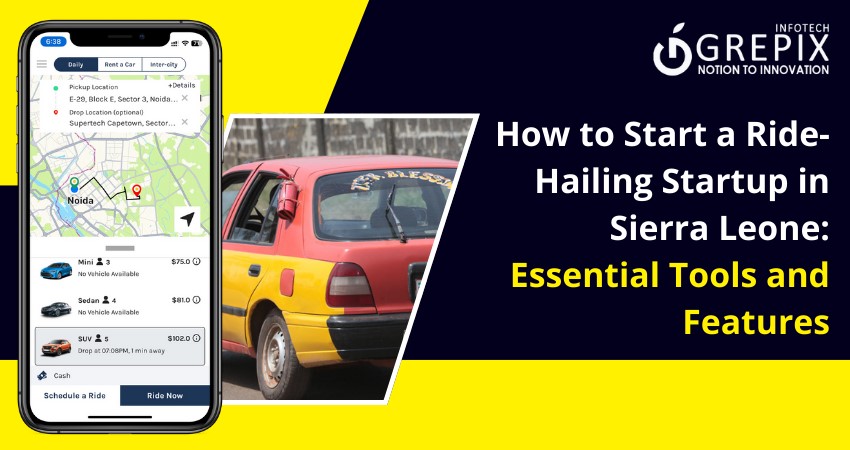How to Start a Ride-Hailing Startup in Sierra Leone: Essential Tools and Features
The ride-hailing revolution has transformed urban transportation across the globe, with tech-enabled platforms like Uber, Bolt, and Lyft turning traditional taxi services on their heads. But while major cities in the West have been the early adopters, there's a new frontier waiting to be explored: Africa. Among African nations, Sierra Leone presents a compelling opportunity for innovative entrepreneurs ready to tap into a market that’s still wide open for disruption.
Think about it, crowded buses, unreliable taxis, traffic chaos, and long wait times. If you live in or have visited Freetown, you already know the struggle. Sierra Leone’s public transportation system is often stretched thin, and that’s where a modern, app-based ride-hailing service could come in and change the game. With a youthful population, increasing smartphone penetration, and a growing appetite for convenience, the timing couldn’t be better.
In this guide, we’ll walk you through everything you need to launch a taxi business in Sierra Leone from understanding the local market to choosing the right tech tools, developing your app, marketing it, and ultimately scaling up.
Sierra Leone is primed for a ride-hailing revolution. With increasing urban congestion and growing smartphone adoption, there is a huge market gap for modern, app-based transport. By launching a ride-hailing startup with essential tools like driver onboarding systems, real-time tracking, multiple payment options, and a powerful admin panel, you can meet this demand effectively. Partnering with Grepix helps entrepreneurs skip months of development. Our white-label taxi app solutions offer fast deployment, customizable branding, and full technical support. Whether you're targeting city taxis, intercity travel, or on-demand deliveries, Grepix has the right platform to support your growth in Sierra Leone.
1Introduction to Ride-Hailing in Sierra Leone
Imagine trying to hail a cab in the bustling streets of Freetown without an organized system in place. Frustrating, right? That is where the opportunity lies. Sierra Leone is a country with a growing need for accessible, reliable, and safe transportation options. Despite the expansion of urban areas and a steady rise in mobile phone usage, traditional taxi services remain largely unorganized and inefficient.
Ride-hailing services have completely transformed the way people move in cities across the world, from New York to Lagos. In Sierra Leone, this transformation is just beginning, presenting a golden opportunity for entrepreneurs ready to innovate. With a reliable taxi app, commuters can enjoy door-to-door transportation without the hassle of street haggling or uncertainty.
Moreover, the socio-economic landscape in Sierra Leone is ripe for tech-driven solutions. With a focus on ease of use, affordability, and driver accountability, ride-hailing can provide solutions for both daily commuters and tourists exploring the country. Starting a ride-hailing business here is not just a smart move; it is a timely one.
2 Why Start a Ride-Hailing Business in Sierra Leone
If you are wondering why now is the perfect time to launch a ride-hailing startup in Sierra Leone, let me break it down for you.
First, Sierra Leone's urban areas are growing rapidly. Cities like Freetown, Bo, and Kenema are becoming increasingly congested, yet they lack an efficient, tech-driven transportation system. This gap in service represents a huge market opportunity.
Second, smartphone adoption is on the rise. According to recent data, mobile penetration has crossed 80 percent, and internet connectivity is improving steadily. That means your potential customers are already equipped with the main tool needed to access your service.
Third, organized public transportation is almost non-existent. Minibuses and shared taxis dominate the landscape, but they often operate without set routes or schedules. For working professionals, students, and tourists, an app-based ride-hailing solution would be a game-changer.
Finally, Sierra Leone's government is showing increasing openness toward private sector innovation. There is a strong push for digital transformation, and transportation is a key sector targeted for reform. Early movers will have the distinct advantage of building brand loyalty before the market becomes saturated.
If you act now, you can establish yourself as a trusted brand before competitors flood the market.
3Key Market Research Before Starting
Before jumping into the taxi app business, thorough market research is non-negotiable. Think of market research as the foundation of a skyscraper; without it, the whole structure can come crashing down.
Start by understanding your target audience. Are you focusing on daily commuters, tourists, business professionals, or students? Each group will have different needs and expectations. For example, tourists may prioritize safety and language-friendly drivers, while daily commuters look for affordability and availability.
Next, identify existing competitors. Even if there are no major ride-hailing companies yet, traditional taxi services and local minibus operators are indirect competitors. Analyze what they offer, what they lack, and how you can position your service as a better alternative.
Assess demand and supply gaps. Is there a shortage of taxis during peak hours? Are some neighborhoods underserved? Mapping out these pain points will help you strategically launch your services where they are needed the most.
Lastly, conduct surveys, interviews, or even informal discussions to gather firsthand insights. In emerging markets like Sierra Leone, real-world feedback is often more valuable than statistics alone.
Armed with this research, you will be ready to craft a winning business plan.
4Building a Business Plan for Your Taxi Startup
A business without a plan is like a ship sailing without a compass. Crafting a detailed and strategic business plan is critical for your success.
Start by clearly defining your vision and mission. Your vision might be something like "To become the leading ride-hailing service in Sierra Leone by offering safe, affordable, and accessible transportation to all.
Then, break down your operational strategies. How many drivers will you onboard in the first three months? Will you start with one city or several? How will you ensure vehicle quality and driver professionalism?
Next, focus on your financials. Prepare detailed financial projections including expected costs (app development, marketing, driver onboarding, insurance) and projected revenues. Factor in different pricing models like base fares, per-kilometer charges, and waiting fees.
Also, consider marketing strategies early on. A strong launch campaign can make or break your business. Budget for digital ads, partnerships, and public relations.
Finally, outline your contingency plans. What will you do if the app faces downtime? How will you handle customer complaints or accidents?
A well-thought-out business plan is not just for securing funding; it is your roadmap to sustainable growth.
5Essential Legal and Regulatory Requirements
Starting a taxi business in Sierra Leone means playing by the rules. Trust me, getting your legal framework right from the beginning will save you from major headaches down the line.
First, register your business entity. You can choose to register as a sole proprietorship, partnership, or limited liability company, depending on your scale and future goals.
Second, ensure all vehicles meet government transportation regulations. In Sierra Leone, taxis must be properly licensed and insured. You may need to work closely with the Ministry of Transport and Aviation to stay compliant.
Driver regulations are another crucial area. Implement strict driver background checks, require professional driving licenses, and offer training programs focused on customer service and safety.
Additionally, your company must have insurance coverage. This should include both vehicle insurance and general liability insurance to protect against accidents, theft, and other risks.
Finally, keep in mind data protection laws. Since you will be collecting sensitive rider and driver information, you must implement strong data security measures in your app and operations.
By ticking all the legal boxes upfront, you will build a trustworthy brand that both customers and drivers will be eager to join.
6Must-Have Features for a Successful Ride-Hailing App
Think of your ride-hailing app as the heart of your business. It is not just a tool it is the entire experience. A well-designed app can make or break your startup. Let's dive into the features your app absolutely must have to succeed in Sierra Leone's emerging market.
Rider App Features
Your rider app should be as intuitive as possible. Users should be able to book a ride in a few taps. Key features include:
- User Registration/Login: Allow registration via email, phone number, or social login for ease.
- Live GPS Tracking: Riders need to see where their driver is in real time.
- Ride Scheduling: Give users the option to book rides in advance.
- Fare Estimation: Display an upfront fare to avoid surprises.
- In-App Chat and Call: Let riders and drivers communicate without sharing personal numbers.
- Multiple Payment Options: Offer mobile money, card payments, and cash.
- Rating and Feedback System: Users should be able to rate drivers and provide feedback.
- Trip History: Riders should access past rides and download receipts.
Driver App Features
A smooth driver experience ensures long-term loyalty. Include features like:
- Driver Onboarding: Let drivers upload documents and complete registration digitally.
- Trip Alerts and Navigation: Instant ride alerts and Google Maps integration are essential.
- Earnings Dashboard: Drivers need real-time access to their daily, weekly, and monthly earnings.
- In-App Wallet: Track balance for rides and bonuses.
- Support and Help: Provide a built-in help center for driver support.
Admin Dashboard Essentials
The admin panel is your command center. You need it to:
- Manage Users and Drivers: Add, block, or update details.
- Control Pricing: Adjust fares, commissions, and incentives in real time.
- View Analytics: Track number of rides, active drivers, peak times, and revenues.
- Dispatch Management: Manually assign rides during emergencies.
- Reports Generation: Download business performance and tax reports.
Together, these tools ensure seamless operation and user satisfaction.
7Choosing the Right Technology Stack
Your technology stack is the engine under your ride-hailing business's hood. Choose wrong, and you could be stuck on the digital roadside. Choose right, and you zoom ahead of competitors.
Start with frontend technologies. The user interface (UI) should be fast and responsive. For Android apps, Java or Kotlin is recommended. For iOS, use Swift. You can also opt for cross-platform solutions like Flutter or React Native to build both versions from one codebase faster and more cost-effective.
For the backend, use scalable and robust technologies like Node.js, Python (Django), or PHP (Laravel). Pair these with cloud-based platforms like AWS or Google Cloud to ensure 99.9 percent uptime and global access.
Don't forget the database layer. Use secure databases like MongoDB or PostgreSQL. Data storage, especially for personal and payment info, must be encrypted.
Add APIs for Google Maps, Twilio for messaging, Firebase for push notifications, and Stripe or Paystack for payments.
Security is paramount. Use SSL certificates, two-factor authentication, and regular vulnerability scans to keep user data safe.
A solid tech stack ensures that your app runs smoothly, scales effortlessly, and remains secure from day one.
Also Read: "Accelerating Your Fortune: Becoming a Billionaire in South Africa's Taxi Industry"
8Payment Integration and Cashless Transactions
A solid tech stack ensures that your app runs smoothly, scales effortlessly, and remains secure from day one.
In Sierra Leone, mobile money is king. Any ride-hailing app that wants to thrive must embrace cashless transactions. Here's how to do it right.
A solid tech stack ensures that your app runs smoothly, scales effortlessly, and remains secure from day one.
Next, include card payment options for users with bank accounts and debit cards. Services like Paystack and Flutterwave can be used to bridge this integration easily and securely.
Also, keep the cash payment option available initially. Some users, especially first-timers, may still prefer paying cash. Over time, you can incentivize digital payments through discounts and reward points.
Your app should also feature a wallet system where users can preload money and pay instantly with a single tap. This reduces ride cancelations and simplifies driver payouts.
Moreover, implement instant driver payouts. Enable drivers to transfer their earnings to mobile wallets or banks without delay. This builds trust and driver satisfaction.
Seamless payment systems make your platform more reliable, improve user experience, and reduce operational costs linked to handling cash.
9How to Recruit and Retain Drivers
Your drivers are your frontline soldiers. Without them, your business can't operate. Here's how to recruit them smartly and keep them happy long term.
Driver Recruitment
Begin by launching a citywide driver recruitment campaign. Use flyers, community radio stations, and word of mouth. Offer sign-up bonuses to attract initial drivers.
Your recruitment strategy should focus on:
- Minimum vehicle requirements: Age, model, condition
- Valid documentation: Driver's license, insurance, vehicle registration
- Background checks: Safety is non-negotiable
Make onboarding simple with digital forms and uploads. Set up offline support centers for drivers who need help.
Driver Retention
Once you have drivers, keeping them loyal is key. Here's what works:
- Driver Incentive Programs: Offer bonuses for trip targets, good ratings, and referrals.
- Fast Payouts: Make earnings easily accessible via mobile money.
- Driver Training: Provide customer service and app usage training.
- Feedback Loop: Listen to driver concerns and act promptly.
Also, create a driver loyalty program. Offer rewards for long-term partnerships think fuel vouchers, maintenance support, or exclusive app features.
A happy driver base translates into better service, fewer cancellations, and higher customer satisfaction.
10Marketing Strategies to Launch Your Taxi App
Launching a ride-hailing app is like opening a new restaurant if no one knows about it, they won't show up. Let's talk about how to get noticed in Sierra Leone's vibrant but competitive market.
Pre-Launch Hype
Before you go live, build excitement. Use countdowns on social media, teaser videos, and email signups with early bird rewards.
Collaborate with local influencers and community figures to create buzz. Host small launch events or press briefings to demonstrate your app's features.
Distribute flyers in marketplaces, schools, and transport hubs. Run promo campaigns offering free rides for first-time users.
Launch Phase
During the launch week, you need visibility everywhere. Use Facebook, WhatsApp groups, and Instagram to promote your launch.
Offer special discounts, such as:
- Flat fare rides
- Referral rewards
- Driver bonus programs
Geo-targeted ads in Freetown and other major cities can be highly effective.
Post-Launch Growth
After launch, focus on retention and growth. Track user feedback closely. Tweak your services based on real experiences.
Set up a customer care hotline to handle issues quickly. Run regular surveys to keep a pulse on satisfaction.
Finally, analyze data which areas get most rides? What are peak times? Use this data to plan fleet expansion and optimize services.
With a strong marketing plan, you won't just launch you'll lead.
11How Grepix Helps Accelerate Your Taxi App Launch
When you are ready to bring your ride-hailing dream to life, you need a reliable technology partner that understands the local market and delivers fast. That's where Grepix Infotech steps in.
Grepix is not just another software provider. They specialize in ride-hailing app development and have helped countless startups across Africa, Asia, and beyond launch their taxi platforms quickly and efficiently.
With Grepix, you do not need to reinvent the wheel. Their white-label taxi app solutions are built with a plug-and-play architecture. That means your app is already developed all you need is to customize it with your brand colors, logo, language, and business model.
They offer complete technical support from app setup and testing to deployment on both Android and iOS platforms. Whether you are launching in one city or multiple zones across Sierra Leone, Grepix has the infrastructure to support you.
The best part? Their solutions are scalable. You can start small and expand as demand grows, without rebuilding the entire system. For entrepreneurs in Sierra Leone, this eliminates months of development time and massive upfront costs.
12Grepix Ride-Hailing App Features
Grepix's taxi app ecosystem includes three core components: the rider app, the driver app, and the admin dashboard. Let's explore what makes them so powerful.
Rider App Highlights
- Real-time tracking: Riders can see their driver approaching in real-time.
- Fare estimation: Know the cost before you book.
- Ride history: Full access to all past rides and payments.
- Multiple payment methods: Cash, cards, and mobile wallets supported.
- In-app support: Easy resolution of issues within the app.
Driver App Highlights
- Instant trip requests: Real-time ride alerts for nearby pickups.
- Navigation assistance: Integrated with Google Maps for turn-by-turn directions.
- Earnings overview: Track commissions, bonuses, and daily summaries.
- Status toggle: Drivers can go online or offline with a tap.
- Payout module: Request and receive earnings seamlessly.
Admin Dashboard Highlights
- User management: Control rider and driver access.
- Revenue tracking: See income by city, day, or service type.
- Promo code and discount tools: Launch marketing offers on the fly.
- Driver verification tools: Automate document checks and approval processes.
- Reports and analytics: Detailed insights to guide decision-making.
Together, these features provide a fully automated, user-friendly, and robust ride-hailing platform tailored for Sierra Leone.
13Advantages of Partnering with Grepix
Choosing Grepix as your app development partner means you're not just buying software you're investing in a partnership built on results.
Here's why new entrepreneurs in Sierra Leone trust Grepix:
- Speed to Market: Launch your taxi app in just 5 to 7 days.
- White-label Customization: Tailor everything to match your brand identity.
- Technical Support: Get 24/7 assistance, updates, and maintenance.
- Multi-language and Currency Support: Perfect for local and diaspora users.
- Affordable Pricing: Designed with startups in mind cost-effective packages with no hidden charges.
- Proven Experience: Grepix has helped ride-hailing companies scale across Africa, from Uganda to Nigeria to Ghana.
For a country like Sierra Leone, where digital transformation is gaining speed, Grepix offers a solid shortcut to success. They take care of the tech so you can focus on operations and scaling your business.
14Real Success Stories with Grepix
Grepix has an impressive portfolio of successful ride-hailing launches. These real-world examples prove their technology and support system work flawlessly in dynamic environments like Sierra Leone.
RideApp in Uganda
This startup launched in Kampala and grew to over 10,000 active riders in six months. Grepix's fast deployment and continuous updates helped RideApp scale across the country without any major tech issues.
GoRide in Nigeria
GoRide started as a motorcycle-taxi platform but later expanded into cars and delivery services. With Grepix, they added new modules without rebuilding the core app.
WakaWaka in Ghana
Focused on city-to-city inter-state travel, WakaWaka used Grepix's multi-city support system to manage complex routes and pricing structures.
These stories show that Grepix doesn't just build apps they build platforms for growth, adaptability, and long-term sustainability.
Conclusion
Starting a ride-hailing business in Sierra Leone is more than just an entrepreneurial pursuit it's an opportunity to solve real transport issues in an evolving urban ecosystem. The rise in smartphone use, growing urban density, and underdeveloped transport infrastructure make the country ripe for disruption.
The ride-hailing revolution has already reshaped urban transportation in the developed world, but Africa particularly Sierra Leone—is just getting started. With its fast-growing urban centers, improving digital infrastructure, and a population eager for convenience, Sierra Leone is a land of opportunity for tech-savvy entrepreneurs. Crowded minibuses, unreliable taxi systems, and traffic bottlenecks are all signs of a system crying out for innovation. The solution? A robust, user-friendly, and efficient ride-hailing platform that can bring structure, safety, and speed to everyday travel.
But let’s face it: starting from scratch can be overwhelming. Between market research, app development, legal compliance, and marketing, launching a ride-hailing startup in Sierra Leone is no small feat. That’s where Grepix Infotech becomes a game changer.
Grepix is not just another development firm, We are ride-hailing specialists. Our white-label taxi app solutions give you the technological edge without the hassle of building from zero. Imagine getting a ready-to-launch platform fully customized to your brand, language, and payment systems, in under a week. Sounds too good to be true? It’s not. Grepix has already done it in markets like Nigeria, Uganda, and Ghana, helping startups grow from concept to citywide dominance.
With a feature-rich rider and driver app, real-time tracking, integrated mobile money payments, and a powerful admin panel, Grepix empowers you to deliver a world-class ride-hailing experience. And as your business grows, their platform grows with you—offering scalability, multi-city support, and new modules like delivery or intercity travel.
In a country where reliable transport options are scarce but smartphone adoption is booming, launching a ride-hailing service could be your golden ticket. And with Grepix as your tech partner, you can hit the ground running, avoid costly delays, and focus on building a brand that truly changes how Sierra Leone moves.
Ready to ride the wave of digital transformation? Grepix Infotech is the key to turning your ride-hailing dream into reality fast, affordably, and flawlessly.
FAQs
1. How much does it cost to build a ride-hailing app in Sierra Leone?
It depends on features, but with Grepix's white-label solutions, you can launch for a fraction of the traditional cost starting as low as a few thousand dollars.
2. What features are essential in a taxi booking app?
Core features include real-time tracking, fare estimates, multiple payment options, rider and driver ratings, trip history, and an admin panel for operations.
3. How does Grepix support new ride-hailing startups?
Grepix offers ready-made, customizable apps, branding, tech support, and fast deployment within 5 to 7 days, along with ongoing maintenance.
4. What are the legal requirements to start a taxi business in Sierra Leone?
You need business registration, vehicle licensing, driver verification, insurance coverage, and compliance with transport regulations.
5. How fast can I launch a ride-hailing app with Grepix?
Grepix can help you launch your fully customized ride-hailing app in just 5 to 7 days, depending on your branding and integration needs.
Looking out to start your own venture like Uber? Try out our HireMe Taxi Uber Clone, the easiest way to kick-start your taxi business.







